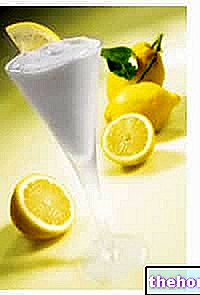Definition and origin
Wine is an alcoholic beverage obtained by fermenting the fructose contained in the grape (or its pressing, called must), fruit of the vine (vitis vinifera), by fungi belonging to the saccharomycetes family.

To date, wine production is widespread all over the world; specifically, Italy is one of the most representative countries for the high quality of the products, obtained thanks to the deep tradition, culturally rooted.
The study of wine in all its aspects (from production to tasting) is said oenology, while in the restaurant business the commercial and taste manager, mainly engaged in combinations with food, defines himself sommelier.
Classification
Wine is classified on the basis of:
- of the production area
- of the vine of production of the grape (type of vitis vinifera)
- color (white, pink or red)
The most famous red vines are: Cabernet-Sauvignon, Cabernet franc, Merlot, Pinot noir, Zinfandel and Syrah; while the most famous grape varieties among the whites are: Sauvignon, Chardonnay, Muscat and Riesling.
NB. The color of the wine depends on the type of grape used and the type of vinification; by pressing the grapes without macerating it is possible to obtain a white wine also from red grapes (as the color is given by the skin), while by dosing the maceration it is possible to manage the color of the drink. To obtain a rosé wine it is possible: either to use a mild maceration of red grapes, and a sustained maceration of a mix of white and red grapes (called uvagio). A white wine, "full-bodied" and with a very marked yellowish pigmentation, is produced by vinification of white grapes but with a good maceration time.
Lightweight Biscuits with Wine Without Eggs and Butter
Problems with playing the video? Reload the video from youtube.
- Go to the Video Page
- Go to the Video Recipes Section
- Watch the video on youtube
Composition
The composition of the wine depends on three factors:
- Type of grape
- Fermentation
- Winemaking technique
Wine, being an alcoholic beverage, is mainly made up of water (80-90%) and alcoholic molecules; these include:
- Ethyl alcohol (ethanol - C2H5OH): it is the product of the microbial fermentation of sugars
- Glycerin (1, 2, 3-propantriol,): it is contained in portions of 4-15 g / l, derives from fermentation and increases as the alcohol content increases
- Methyl alcohol (methanol - CH3OH): it is contained in wine in small portions, equal to 20-200mg, while at higher concentrations it becomes potentially toxic.It derives from the fermentation of the pectin contained in the peel; therefore, the higher the maceration of the grapes (from six to ten days) and the more the concentration of methanol increases
- Higher alcohols (l-propanol, 2-methyl-l-propanol, 3-methyl-l-butanol)
- Butylene glycol: it is a secondary polyalcohol of alcoholic fermentation and its concentration is around 0.3-0.5 g / l
- Sugars: their coordination depends on the level of fermentation and on the added share. Those most present are fructose and glucose, but there is also a portion of NON-fermentable carbohydrates composed of xylose and arabinose
- Organic acids: there are more than 50 types and together they contribute to the total acidity of the wine, which however is chemically expressed in g / l of tartaric acid.
- Nitrogen substances: these are the same contained in grapes, but in lower quantities
- Phenolic substances: they derive from grapes and not from microbial fermentation, but their concentration also depends on the type of vinification. If the maceration of the must is used, the quantity of polyphenols in the wine is directly proportional to the maceration time, even if the type of grapes used represents a "further not indifferent variable. Polyphenols make up the color, aroma and stability of the wine.
NB. Some phenolic substances are transferred from the aging barrel to the wine.
- Mineral substances: they come from grapes and are mainly: magnesium (Mg), sodium (Na), calcium (Ca) potassium (K), phosphates, sulphates and chlorides, for a total of 2-3 g / l.
- Aromatic substances: primary or varietal aromas, pre-fermentation aromas, fermentation aromas, post-fermentation aromas
- Vitamins: these are the same contained in grapes, except for the ascorbic acid (vitamin C) which disappears with the vinification.
- Dissolved gases: carbon dioxide, oxygen and sulfur dioxide (additive).
sangria
Problems with playing the video? Reload the video from youtube.
- Go to the Video Page
- Go to the Video Recipes Section
- Watch the video on youtube
Wine in the Diet

"in the SANA adult population," daily alcohol intake with meals can reach 40 g in males and 30 g in women "
... and this means that, assuming an average alcohol content of 10-11 g per 100 ml of wine, it is allowed to drink up to 3 glasses (125 ml) of wine for men daily, and just over two glasses for women ; in the elderly the quantity is reduced to 30 g in males and 25 g in females.
NB. It is not recommended to consume wine in: pregnancy, under 18 years of age, Diabetes Mellitus, taking certain medications, driving cars.
If liked (and this does NOT mean that systematic consumption is recommended), wine (especially red) brings a significant amount of polyphenols (especially tannins and flavonoids, the most famous of which is resveratrol). These are newly discovered molecules that possess excellent health abilities among which we remember:
ANTIOXIDANT - ANTICANCEROGENIC - ANTIATEROGENIC
In conclusion, it is advisable to drink wine only if you like it and also in this case not to exceed the rations recommended by the LARN. The contribution of polyphenols is undoubtedly considerable and contributes to the achievement of a sufficient quantity of human nutrition, however, the relative alcoholic concentration limits its consumption to the adult and healthy population; therefore, in special pathological or physiological states it is advisable to introduce dietary polyphenols through portions of fresh fruit and vegetables, and extra virgin olive oil.
Other Alcoholic Alchermes Alcohol test Alcopops Cocktail Alcoholic Alcoholic units calculation Cognac Gin Grappa Alcoholic degree Grappa Limoncino Maraschino Marsala Nocino Prosecco Rum Rum Sherry Sparkling wine Spirits Wine Port wine Vermouth Vodka Vov Whiskey Categories Alcoholic foods Meat Cereals and derivatives Sweeteners Sweets Offal Dried fruit Milk and derivatives Legumes Oils and fats Fish and fishery products Cold cuts Spices Vegetables Health recipes Appetizers Bread, Pizza and Brioche First courses Second courses Vegetables and salads Sweets and desserts Ice creams and sorbets Syrups, liqueurs and grappas Basic preparations ---- In the kitchen with Leftovers Carnival recipes Christmas recipes Light diet recipes Women's, mom's and dad's day recipes Functional recipes International recipes Easter recipes Celiac recipes Diabetic recipes Holiday recipes Valentine's Day recipes Vegetarian recipes Protein recipes Regional recipes Vegan recipes




























